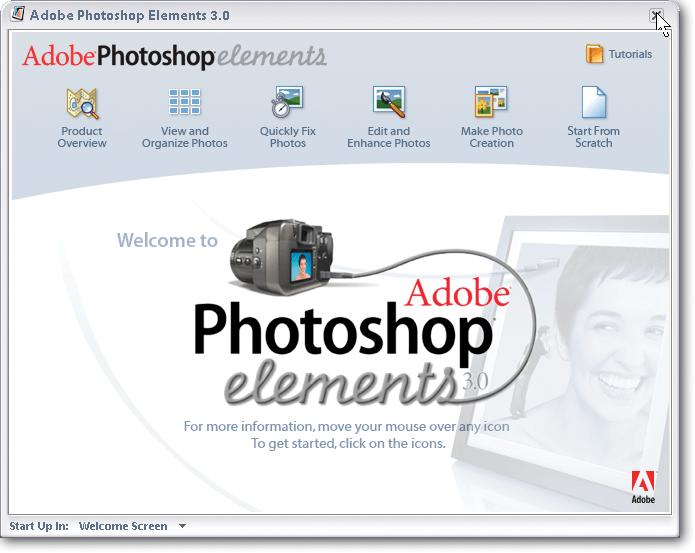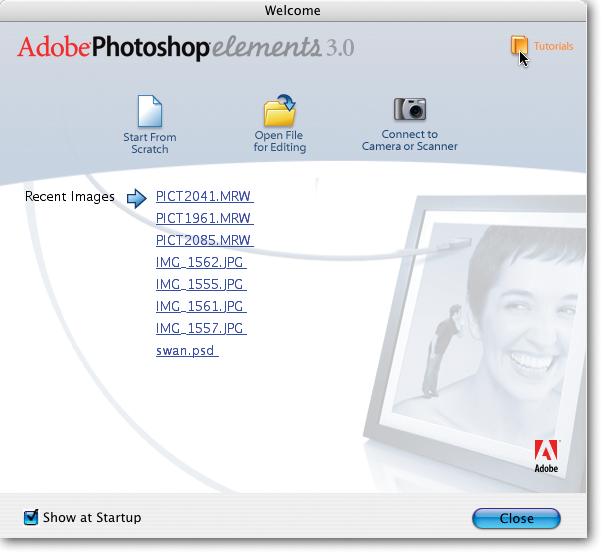Photoshop Elements lets you do practically anything you want to your digital images. You can colorize black and white photos, remove demonic red-eye stares, or distort the facial features of people who've been mean to you. The downside is that finding your way around the program has gotten a lot more complicated than it used to be, especially if you're using the Windows version.
This chapter helps get you oriented in Elements. You'll learn about what to expect when you start up the program, and how to use Elements to fix your photos with just a couple of keystrokesâa great new feature in this version.
Along the way, you'll find out about some of Elements' basic controls and how to get hold of the program's Help files if you need them. Elements is absolutely crammed with help at every turn. Adobe did their best to make it as easy for you as possible.
When you launch Elements for the first time, you get a veritable smorgasbord of options, all neatly laid out for you in the Welcome screen (the Windows version is shown in Figure 1-1 and the Mac version in Figure 1-2).
Figure 1-1. The Windows Welcome screen gives you six main activities to choose from (there's also a Tutorials link in the upper-right corner). Hold your cursor over any of these options for more details about each choice. You can't bypass the Windows Welcome screen just by clicking the Close button. If you do, the screen goes awayâbut so does Elements. Fortunately, you've got options: the box on page 6 tells you how to permanently get rid of the Welcome screen.
Interestingly, the Windows Welcome screen is not actually Elements. It's a launching pad that, depending on the button you click, will start up one of two different programs:
Organizer, which lets you store and organize your image files.
Editor, which lets you edit your images.
It's quite easy to get back and forth between the Editor and the Organizerâwhich you might call the two different faces of Elementsâand you probably won't do much in one without eventually needing to get into the other. But in some ways, they still function as two separate programs. In any case, the Welcome screen offers you no less than six choices for how to get into Elements:
Product Overview offers a round-up of all the features inside Elements.
View and Organize Photos takes you to the Organizer, where you can store and sort all your images.
Quickly Fix Photos brings you to the wonderful new Quick Fix window (which is actually part of the Editor) where you can perform amazing color corrections with just a click.
Edit and Enhance Photos takes you to the Editor, which is the digital darkroom/art studio where you can perform your most extensive edits.
Make Photo Creation enables you to use your photos in a wide variety of projects like greeting cards and slideshows. You perform all these tasks in the Organizer.
Start From Scratch provides you a new blank document in the Editor to noodle away on.
Tip
The boxed version of Elements for Windows includes a half-hour video introduction to the program, led by Photoshop guru Deke McClelland. It's a good overview of some of the main features of Elements. To see it, fire up the Elements CD, click past the legal stuff, and click Product Overview. Windows Media Player launches, and Deke speaks.
If you start in the Organizer, once you've located a photo to edit, you have to wait while the Editor loads. And if you have both the Editor and the Organizer running, quitting the Editor doesn't close the Organizer. You have to close both programs independently.
If you have a Mac, on the other hand, life is far less complex, since you only have one program to deal with: Elements. You'll either use Elements' File Browser or iPhoto to organize your photos. Adobe's made the reasonable guess that Mac fans will prefer to use iPhoto for many of the tasks Organizer handles for Windows folks, like online print and book ordering, or any other organizing program you might already be using.
Elements on the Mac opens right into the Standard Edit window and presents the Welcome screen, as shown in Figure 1-2, which lets you choose to connect to your camera or scanner, browse for files, start a new file, or open a recent one.
Get Photoshop Elements 3: The Missing Manual now with the O’Reilly learning platform.
O’Reilly members experience books, live events, courses curated by job role, and more from O’Reilly and nearly 200 top publishers.



